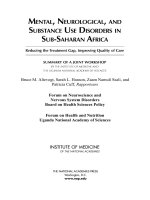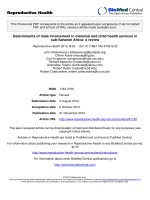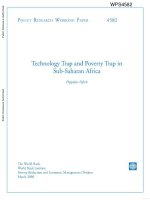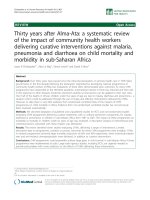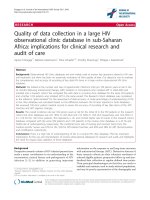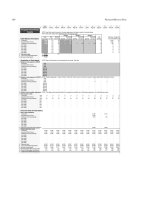Development planning and hivaids in sub saharan africa phần 1 ppt
Bạn đang xem bản rút gọn của tài liệu. Xem và tải ngay bản đầy đủ của tài liệu tại đây (669.09 KB, 21 trang )
Development planning and HIV/AIDS in sub-Saharan Africa
Development planning and
HIV/AIDS in sub-Saharan Africa
By Mirjam van Donk
Final Report
Prepared for the UNDP
Regional Project on HIV and
Development in sub-Saharan Africa
July 2004
Development planning and
HIV/AIDS in sub-Saharan Africa
By Mirjam van Donk
Final Report
Prepared for the UNDP
Regional Project on HIV and
Development in sub-Saharan Africa
July 2004
UNDP Regional Service Center
7 Naivasha Road, Sunninghill 2157, Johannesburg
South Africa
Tel: 27 11 603 5000
Fax: 27 11 603 5071
Development planning and HIV/AIDS in sub-Saharan Africa
Development planning
and HIV/AIDS in
sub-Saharan Africa
By Mirjam van Donk
Final Report
Prepared for the UNDP Regional
Project on HIV and Development
in sub-Saharan Africa
July 2004
FOREWORD 1
ACKNOWLEDGEMENTS 2
ACRONYMS 3
1. INTRODUCTION 5
1.1. Introduction 5
1.2. Background to the study 5
1.3. Study aim and activities 5
1.4. Project management and execution 6
1.5. Overview of the report 6
2. DEVELOPMENT PLANNING IN SUB-SAHARAN AFRICA: A BRIEF OVERVIEW 9
2.1. Introduction 9
2.2. Four fundamental challenges 9
2.3. Responses to development challenges and progress achieved, 1950s-1999 10
The 1950s and 1960s: the development era 10
The 1970s: crisis in development planning 11
The 1980s: structural adjustment 13
The 1990s: ‘structural adjustment with a human face’ 15
2.4. Concluding comments 17
3. A TYPOLOGY OF DEVELOPMENT PLANNING IN SUB-SAHARAN AFRICA 21
3.1. Introduction 21
3.2. When planning fails: contested perspectives 21
3.3. (Re)Defining development planning 22
3.4. Typology of development planning and associated frameworks 23
Key types of development planning in sub-Saharan Africa 24
Principal development planning frameworks 25
3.5. Issues of integration and alignment 29
4. DEVELOPMENT PLANNING AND HIV/AIDS: AN ASSESSMENT OF PRINCIPAL
DEVELOPMENT PLANNING FRAMEWORKS 31
4.1. Introduction 31
4.2. Conceptual shifts for an expanded response to HIV/AIDS 31
4.3. HIV/AIDS: a three-pronged response 32
Prevention 32
Treatment and care 33
Impact mitigation 33
4.4. Development planning and HIV/AIDS: a tentative framework for assessment 34
4.5. Exploring possible links between development planning and HIV/AIDS 38
National Strategic Framework for HIV/AIDS 38
PRSP 39
MTEF 40
Sector Plans 41
Rural / Urban Development Frameworks 43
4.6. Concluding observations 44
5. INTRODUCTION TO THE COUNTRY ASSESSMENTS 47
5.1. Introduction 47
5.2. The selection process 47
Development planning frameworks 48
HIV prevalence 48
Status of development and other criteria 48
5.3. Comparison of development profile of selected countries 51
Adult HIV prevalence rate 51
Life expectancy 51
Trends in GDP growth 52
GNI per capita 53
Concluding comments 53
5.4. Research methodology for country assessments 54
Research questions 54
Research methodology 54
Research process 55
Challenges and difficulties encountered 56
5.5. Structure of the country assessments 56
6. CAMEROON 57
6.1. Introduction 57
6.2. Overview of development trends since 1980 57
Demographic trends 57
Economic performance and structure of the economy 58
Poverty and inequality 58
Human development 59
HIV/AIDS 60
Conclusion 61
6.3. The core determinants and key consequences of HIV infection in Cameroon 61
Core determinants 61
Key consequences 62
6.4. Development planning and HIV/AIDS in Cameroon 63
Development planning in Cameroon in historical context 63
The PRSP, 2003-2015 64
The MTEF, 2003-2015 67
The Strategic Framework for the Fight Against AIDS, 2000-2010 69
The Health Strategy, 2001-2010 73
The Education Strategy, 2001-2011 75
The Rural Development Strategy (DSDSR), 2002-2004 77
The planning process 79
Alignment and implementation of development planning frameworks 80
Concluding comments 81
6.5. Conclusion 82
7. SENEGAL 83
7.1. Introduction 83
7.2. Overview of development trends since 1980 83
Demographic trends 84
Economic performance and structure of the economy 84
Poverty and inequality 84
Human development 85
HIV/AIDS 86
Conclusion 87
7.3. The core determinants and key consequences of HIV infection in Senegal 88
Core determinants 88
Key consequences 89
7.4. Development planning and HIV/AIDS in Senegal 89
Development planning in Senegal in historical context 89
The 10
th
Economic and Social Development Plan, 2002-2007 91
The PRSP, 2002-2015 92
The Strategic Framework for the Fight Against AIDS, 2002-2006 93
The National Plan for Health Development (PNDS), 1998-2007 95
The Development Framework for Education and Training (PDEF), 2000-2010 97
The Kaolack Regional Integrated Development Plan (PRDI), 2001-2005 98
The planning process 101
Alignment and implementation of development planning frameworks 102
Concluding comments 102
7.5. Conclusion 103
8. UGANDA 105
8.1. Introduction 105
8.2. Overview of development trends since 1980 105
Demographic trends 105
Economic performance and structure of the economy 106
Poverty and inequality 106
Human development 107
HIV/AIDS 108
Conclusion 109
8.3. The core determinants and key consequences of HIV infection in Uganda 109
Core determinants 110
Key consequences 111
8.4. Development planning and HIV/AIDS in Uganda 112
Development planning in Uganda in historical context 112
The Poverty Eradication Action Plan (PEAP) 2001 113
The MTEF, 2003/04-2005/06 115
The National Strategic Framework for HIV/AIDS Activities (NSFA), 2000/01-2005/06 118
The Plan for Modernisation of Agriculture (PMA) 2000 119
The Health Sector Strategic Plan (HSSP), 2000/01-2004/05 121
The Education Strategic Investment Plan (ESIP), 1998-2003 123
The planning process 125
Alignment and implementation of development planning frameworks 128
Concluding comments 128
8.5. Conclusion 129
9. ZIMBABWE 131
9.1. Introduction 131
9.2. Overview of development trends since 1980 131
Demographic trends 131
Economic performance and structure of the economy 132
Poverty and inequality 133
Human development 133
HIV/AIDS 133
Conclusion 134
9.3. The core determinants and key consequences of HIV infection in Zimbabwe 135
Core determinants 135
Key consequences 136
9.4. Development planning and HIV/AIDS in Zimbabwe 137
Development planning in Zimbabwe in historical context 138
The National Economic Revival Programme (NERP) 139
The National HIV/AIDS Strategic Framework 141
The 2003 Revival Action Plan, Ministry of Health and Child Welfare 144
The Plan of Action for the Ministry of Education, Sports and Culture 145
The planning process 147
Alignment and implementation of development planning frameworks 148
9.5. Conclusion 149
10. SYNTHESIS OF COUNTRY ASSESSMENTS 151
10.1. Introduction 151
10.2. Development planning and HIV prevention: reducing vulnerability? 151
Factors facilitating HIV spread according to interview respondents 154
10.3. Development planning and the key consequences of HIV infection 155
Key consequences of HIV/AIDS identified by interview respondents 157
10.4 Development planning: an implicit contribution to HIV vulnerability reduction? 158
10.5. Concluding remarks 160
11. CONCLUSION AND RECOMMENDATIONS 163
11.1. Introduction 163
11.2. Key lessons and conclusions 164
11.3. Recommendations 168
BIBLIOGRAPHY 173
Appendices
Appendix 1. Assessing the link between rural development planning and HIV/AIDS 181
Appendix 2. Country Profiles 183
Country Profile of Cameroon 184
Country Profile of Senegal 186
Country Profile of Uganda 188
Country Profile of Zimbabwe 190
Appendix 3. List of respondents 192
LIST OF TABLES, GRAPHS AND BOXES
Tables
Table 2.1. Enrolment ratios in sub-Saharan Africa, 1960-1997 11
Table 2.2. Poverty trends in African LDCs, 1965-1999 14
Table 2.3. Overview of dominant theories of development 19
Table 3.1. Overview of key types of development planning in sub-Saharan Africa, 1960s-1990s 30
Table 4.1. Template to assess possible links between development planning and HIV/AIDS 37
Table 4.2. Assessing the link between economic development planning and HIV/AIDS:
The stabilisation approach of the 1980s 38
Table 5.1. Selected development planning frameworks in eligible countries (end of March 2003) 48
Table 5.2. Selection process and results of the UNDP study 50
Table 6.1. Explicit objectives in Cameroon’s development planning frameworks 78
Table 7.1. Explicit objectives in Senegal’s development planning frameworks 100
Table 8.1. Explicit objectives in Uganda’s development planning frameworks 124
Table 9.1. Possible links between HIV/AIDS and the NERP 142
Table 9.2. Explicit objectives in Zimbabwe’s development planning frameworks 146
Table 10.1. Consideration given to HIV/AIDS in the development planning frameworks of
Cameroon, Senegal, Uganda and Zimbabwe 153
Graphs
Graph 2.1. Poverty trends in African LDCs, 1965-1999 14
Graph 2.2. Trends in GDP growth (%), 1990s 16
Graph 2.3. Trends in GNI per capita (US$) in the 1990s 16
Graph 3.1. Ideal type linkages between development planning frameworks 29
Graph 5.1. Adult HIV prevalence rate in eligible countries, 2001 (%) 49
Graph 5.2. Spread of HIV over time in selected countries 51
Graph 5.3. Life expectancy in selected countries, 1990-2001 52
Graph 5.4. Trends in GDP growth in selected countries, 1980-1999 52
Graph 5.5. Trends in GNI per capita in selected countries, 1980-1999 53
Graph 5.6. From a narrow approach to a developmental approach to HIV/AIDS 55
Graph 6.1. Life expectancy and HIV prevalence rate in Cameroon 60
Graph 7.1. School enrolment in Senegal, 1991-1999 85
Graph 7.2. Senegal’s planning system 90
Graph 8.1. GDP per capita in Uganda, 1980-2000 107
Graph 9.1. GDP growth (%) in Zimbabwe, 1980-2000 132
Graph 9.2. GNI per capita in Zimbabwe, 1985-2000 132
Graph 9.3. HIV prevalence rates in Zimbabwe, 1990-2001 134
Boxes
Box 2.1. Key characteristics of economic planning in sub-Saharan Africa 13
Box 5.1. Principal planning frameworks and related documents 54
Box 10.1. Most commonly identified factors of vulnerability to HIV infection by respondents 154
Box 10.2. Most commonly identified key consequences of HIV/AIDS by respondents 157
in sub-Saharan Africa. Historically, the approach to
African development has been externally oriented. For the
past four decades, the subcontinent has been negotiating
its development with external partners. More often than
not, this has meant that the process, instruments and
outcomes of development have been determined by
external partners, rather than by African societies and
their leaders.
At the same time, development planning has been
approached as a largely technical, or even technocratic,
exercise. Despite the more recent discourse on
democratising and decentralising planning processes,
development planning still tends to be located in the
domain of planners, and more especially of economists.
Elected representatives, local communities and
organisations representing their interests are only
marginally involved in these processes.
In addition, HIV/AIDS is posing a fundamental challenge
to the conceptual foundations and the practice of
development planning on the subcontinent. The human
tragedy and devastation associated with the HIV/AIDS
epidemic can no longer be ignored by anyone or any
organisation with an interest in Africa’s development.
Even though many dimensions and impacts of HIV/AIDS
are as yet unknown, the time to safeguard the rights of
those infected and affected by HIV/AIDS and change the
course of the epidemic is now.
Against this background, UNDP initiated the study on
“Assessing the Link between National Development
Planning and HIV/AIDS in sub-Saharan Africa”. It starts
from the premise that effective HIV prevention requires a
paradigm shift: one that looks beyond individual
knowledge and behaviour as the most important factors
influencing the spread of HIV to factors in the social,
economic and political environment that render certain
individuals and social groups more vulnerable to HIV
infection than others. Although at the level of rhetoric
there appears to be widespread acceptance that
HIV/AIDS is a development issue, in practice the factors
associated with HIV vulnerability are not sufficiently
understood, let alone responded to. It is here where
development planning can make the most effective
contribution to curbing the spread of HIV. At the same
time, development planning has to pre-empt and mitigate
the current and anticipated impacts of HIV/AIDS, as these
hold the danger of undermining the very goals, targets,
tools and instruments of development. Moreover, if
development planning continues to ignore the develop-
mental dimensions of HIV/AIDS, it may unwittingly fail to
curb – and worse still, even facilitate – the spread of HIV
and it may aggravate the impacts of the epidemic.
This report makes a valuable contribution to the required
paradigm shift in development planning, especially at a
conceptual and practical level. It draws from a broad
development literature and local studies at country level to
substantiate its findings, analysis and recommendations.
It exposes HIV/AIDS as a blind spot in development
planning and makes recommendations to ensure that
HIV/AIDS becomes a central concern in development
efforts in sub-Saharan Africa. It is hoped that the report
will find a wide audience and will contribute to better, more
attuned and locally owned development planning on the
subcontinent.
1
Foreword
By Prof John Ohiorhenuan, Chairperson of the Reference Group and
former Resident Representative UNDP, South Africa
This report has been prepared by Mirjam van Donk for the
UNDP Regional Project on HIV and Development in sub-
Saharan Africa as part of the study “Assessing the Link
between National Development Planning and HIV/AIDS
in sub-Saharan Africa”. Mirjam van Donk has acted as the
Lead Consultant on this project.
The study and this report have benefited from the advice
and support provided by members of the Reference
Group. Members of the Reference Group included: Prof
John Ohiorhenuan (Chairperson), Prof Fantu Cheru, Mr
Mamadou Goudiaby, Mr Edward Kapwepwe, Mrs Eleanor
Maeresera, Dr Roland Msiska, Mrs Mwanakombo
Ngingite, Mr Manual Pinto, Mr Antoine Marie Sie Tioye, Dr
Abdoulmaliq Simone, Dr Alex de Waal and Mr Demile
Yismaw.
Country assessments have been conducted by Prof
Evina Akam (Cameroon), Mr Narathius Asingwire
(Uganda), Mr Amadou Ba (Senegal) and Prof Marvelous
Mhloyi (Zimbabwe). Chapters 6-9 are based on these
country assessments. For the purpose of this report, the
four country assessments have undergone significant
revision by the Lead Consultant.
Administrative support to the project has been provided
by the UNDP Regional Project on HIV and Development
in sub-Saharan Africa. Special thanks are due to Dr
Roland Msiska, Christophe Ahouansou, Jackie Nzisabira
and Leonce Hounkponou.
The author wishes to extend a special thanks to Edgar
Pieterse.
Acknowledge-
ments
2
DEVELOPMENT PLANNING AND HIV/AIDS IN SUB-SAHARAN AFRICA
AIDS Acquired Immune Deficiency Syndrome
ARVs Anti-Retroviral Drugs
BEAM Basic Education Assistance Module (Zimbabwe)
CAMNAFAW Cameroon National Association for Family Welfare
CBHC Community Based Health Care
CBO Community Based Organisation
CNLS National AIDS Council (Comité Nationale de Lutte contre le SIDA)
DSDSR Rural Development Strategy (Document de Stratégie de Développement du Secteur Rural, Cameroon)
EMCCA Economic and Monetary Committee of Central Africa
ESAP Economic Structural Adjustment Programme (Zimbabwe)
ESIP Education Strategic Investment Plan (Uganda)
GDP Gross Domestic Product
GICAM Cameroon Employers’ Federation (Groupent des Industriels du Cameroun)
GNI Gross National Income
HIPC Highly Indebted Poor Countries
HIV Human Immuno-Deficiency Virus
HSSP Health Sector Strategic Plan (Uganda)
IEC Information, Education and Communication
IFIs International Financing Institutions
ILO International Labour Organisation
IMF International Monetary Fund
IRDP Integrated Rural Development Planning
LDCs Least Developed Countries
LRA Lord’s Resistance Army
MAAIF Ministry of Agriculture, Animal Industry and Fisheries (Uganda)
MACA Multi-Sectoral Approach to Control HIV/AIDS
MDGs Millennium Development Goals
MERP Millennium Economic Recovery Programme (Zimbabwe)
MFPED Ministry of Finance, Planning and Economic Development (Uganda)
MINEDUC Ministry of Public Education (Ministère de l’Education Nationale, Cameroon)
MINEPAT Ministry of Economic Affairs, Planning and National Development
(Ministère des Affaires Economiques de la Planification et de l’Aménagement du Territoire, Cameroon)
MINESUP Ministry of Higher Education (Ministère de l’Enseignement Supérieur, Cameroon)
MINSANTE Ministry of Public Health (Ministère de la Santé Publique, Cameroon)
MoES Ministry of Education and Sports (Uganda)
MoLG Ministry of Local Government (Uganda)
MTCS Medium Term Competitive Strategy
MTEF Medium Term Expenditure Framework
NAC National AIDS Council
NACWOLA National Community of Women Living with HIV/AIDS in Uganda
NERP National Economic Revival Programme (Zimbabwe)
NGEN+ National Guidance and Empowerment Network of People Living with HIV/AIDS (Uganda)
Acronyms
3
NGO Non-Governmental Organisation
NPA National Planning Authority
NSFA National Strategic Framework on HIV/AIDS
PAF Poverty Action Fund (Uganda)
PEAP Poverty Eradication Action Plan (Uganda)
PDEF Development Framework for Education and Training
(Plan de Développement de l’Education et de la Formation, Senegal)
PGAT General Plan for National Development (Plan Général d’Aménagement du Territoire, Senegal)
PHC Primary Health Care
PLWHAs People Living with HIV/AIDS
PMA Plan for Modernisation of Agriculture (Uganda)
PMTCT Prevention of Mother-to-Child Transmission
PNAT National Plan for the Development of the Territory
(Plan National d’Aménagement du Territoire, Senegal)
PNDS National Plan for Health Development (Plan National de Développement Sanitaire, Senegal)
PRDI Regional Integrated Development Plan (Plan Régional de Développement Intégré, Senegal)
PRSP Poverty Reduction Strategy Paper
PTIP 3-year Public Investment Plan (Programme Triennal d’Investissements Publics, Senegal)
SAP Structural Adjustment Programme
SMEs Small and Medium Enterprises
SP Sector Programme
SRAT Regional Plan for National Development (Schéma Régional d’Aménagement du Territoire, Senegal)
STI Sexually Transmitted Infection
SWAp Sector Wide Approach
UAC Uganda AIDS Commission
UIS UNESCO Information System
UNAIDS Joint United Nations Programme on HIV/AIDS
UNCTAD United Nations Commission on Trade and Development
UNDP United Nations Development Programme
UNESCO United Nations Educational, Scientific and Cultural Organization
UNMHCP Uganda National Minimum Health Care Package
UPE Universal Primary Education
UPPAP Uganda Participatory Poverty Assessment Project
VCT Voluntary Counselling and Testing
WHO World Health Organization
ZIMPREST Zimbabwe Programme for Economic and Social Transformation
4
DEVELOPMENT PLANNING AND HIV/AIDS IN SUB-SAHARAN AFRICA
1.1. Introduction
HIV/AIDS is one of the most critical development
challenges in sub-Saharan Africa. It is now widely
recognised that HIV/AIDS reverses the
achievements in human development in the region
and, as a consequence, has the capacity to
undermine economic growth and development. The
epidemic also poses a serious challenge to gover-
nance and public sector management in sub-
Saharan Africa. As such, it raises particularly
challenging questions regarding the nature, strate-
gic orientation and impact of development planning
in the region as yet worst affected by HIV/AIDS.
Arguably, development planning seeks to make the
complexities of the real world comprehensible, so
that a government can shape and direct the course
and nature of development to the benefit of its
people and the fulfilment of their basic rights. Past
efforts in development planning in sub-Saharan
Africa have brought significant improvements, but
also great disappointments. From the point of view
of development planning, the human tragedy and
devastation associated with the HIV/AIDS epidemic
clearly adds to the complexity of the real world and
makes the realisation of development goals infinitely
more challenging. Whilst this report does not, and
cannot, provide solutions to these challenges, it
seeks to provide some guidance on how to
approach them.
1.2. Background to the study
Several African governments and international
agencies have sought to curb the spread of HIV and
mitigate the devastating impacts of HIV/AIDS. Yet,
in relation to the scale and devastating nature of
HIV/AIDS, these efforts have at best yielded modest
results. The UNDP Regional Project on HIV and
Development in sub-Saharan Africa has identified at
least three interrelated factors that help to explain
the limited successes of country responses to
HIV/AIDS in the region.
i
Firstly, many prevention efforts have tended to
ignore the social and economic context that renders
certain individuals or social groups more vulnerable
to HIV infection than others. Secondly, successes
made in a few countries – and the social, political
and institutional factors contributing to these
successes – are not well studied to provide viable
and useful lessons elsewhere. Amongst others, this
has led to a replication of interventions that have
demonstrated some level of success in a particular
context, without due regard for the appropriateness
of these interventions in other contexts. Thirdly, few
country responses to HIV/AIDS have been
sufficiently comprehensive and at scale, taking into
account the socio-economic realities of individuals
and communities prior to and after HIV infection.
To overcome these fundamental weaknesses, the
UNDP Regional Project recognises that there is,
firstly, an urgent need for a better understanding of
the relationship between HIV/AIDS and
development and the determinants of the spread of
the epidemic in specific contexts and, secondly, a
need for the development of appropriate methods,
tools and frameworks for mainstreaming of
HIV/AIDS into development programmes at country
level. For this reason, the UNDP Regional Project
commissioned this study. Its aim is to assess
possible links between development planning and
HIV/AIDS in sub-Saharan Africa. More specifically, it
seeks to ascertain the extent to which development
planning may facilitate, or curb, the spread of HIV
and may exacerbate, or mitigate, the impacts and
consequences of HIV infection on households,
communities, organisations and institutions. As
such, the study aims to contribute to the first need
identified above, namely an enhanced under-
standing of relevant political and institutional factors
in the context of HIV and development.
1.3. Study aim and activities
The specific aim of the study is twofold:
Introduction
5
•To develop a typology of development
planning on the subcontinent; and,
•To explore possible links between
development planning and HIV/AIDS through
an analysis of principal development planning
frameworks.
To achieve the aim of the study, the following
research questions have been formulated:
1. What are the most significant development
planning frameworks guiding the development
process on the subcontinent?
2. To what extent are HIV prevention and impact
mitigation deliberate, or integral, objectives of
particular development planning frameworks?
3. How do particular development planning
frameworks, consciously or not:
a. Enhance or diminish an environment of
vulnerability to HIV infection; and/or,
b. Strengthen or undermine the capacity of
households, communities, organisations
and institutions to cope with the impacts
of HIV infection, ill health and possible
death?
The study consisted of various phases. The first
phase was the development of a Concept Paper
Understanding the Link between Development
Planning and HIV/AIDS in sub-Saharan Africa. The
Concept Paper includes a typology of development
planning and key development planning frameworks
in sub-Saharan Africa. It further presents a tentative
conceptual framework for analysis of the possible
linkages between certain types of development
planning (as reflected in key development planning
frameworks) and HIV/AIDS in sub-Saharan Africa.
During the second phase of the study, this
conceptual framework was used as a diagnostic tool
to assess possible links between development
planning and HIV/AIDS in selected countries.
Country assessments were conducted in
Cameroon, Senegal, Uganda and Zimbabwe. The
findings of these country assessments have been
reflected in Country Papers.
ii
The final phase of the study consisted of
consolidating the documentation produced into this
report and preparing a synthesis of the key findings.
The Concept Paper has been restructured and
forms the basis for Chapters 2, 3 and 4 in this report.
The Country Papers have been edited and revised
to ensure coherence and consistency. Furthermore,
a synthesis of the findings reflected in the country
assessments has been written, which has informed
the development of a set of recommendations.
1.4. Project management and execution
As the commissioning authority of this study, the
UNDP Regional Project on HIV and Development in
sub-Saharan Africa played a key role in providing
the necessary administrative support for the
execution of the project. It commissioned a Lead
Consultant to design and manage the project, to
develop the conceptual framework and the research
methodology for the study, and to coordinate the
work of Local Consultants. The Lead Consultant
was also responsible for compiling the final report,
which included editing the Country Papers and
writing a synthesis of the main findings, amongst
others.
Local Consultants were commissioned to conduct
the country assessments. To prepare them for this
task and to ensure a consistent approach among
the various consultants, they participated in a
research methodology workshop in Pretoria, South
Africa. Each Consultant produced a draft Country
Paper and presented this at a Revision Workshop.
Subsequently, the Local Consultants revised their
draft Country Papers, which in some cases involved
additional data gathering.
A Reference Group under the leadership of Prof
John Ohiorhenuan (Resident Representative of
UNDP South Africa) was established to give overall
guidance to the study. An effort was made to ensure
that government representatives of the case study
countries were part of the Reference Group.
iii
Selected international experts with expertise in
development planning and/or HIV/AIDS were also
invited to participate in the Reference Group. In
addition to providing direction to the study and
engaging with the documents produced, members
of the Reference Group were tasked with the
responsibility to assist local consultants in
accessing relevant informants and documents.
1.5. Overview of the report
This report continues by presenting a brief historical
overview of development planning in sub-Saharan
Africa, starting from the period of decolonisation.
Chapter 2 highlights how the first generation of
independent African states, faced with some
fundamental challenges, was able to make
6
DEVELOPMENT PLANNING AND HIV/AIDS IN SUB-SAHARAN AFRICA
significant strides in the first two decades after the
Second World War. Yet, the economic crisis of the
1970s and 1980s exposed some structural weak-
nesses of African economies and their manage-
ment. It further allowed neoliberalism to become the
most dominant ideological framework, with far-
reaching implications for the development project
and development planning in sub-Saharan Africa.
With the declining and discredited role of the state in
development, the concept of development planning
fell into disuse – even though state control and
planning have continued to play a role on the
subcontinent. Chapter 3 argues for a reintroduction
of the notion of development planning as ‘planning
for development’ and emphasises the vital role of
the state in this process. It defines development
planning as a complex, participatory and inherently
conflictual process of decision-making concerning
appropriate priorities, strategies and resource
allocations in the interest of the common good and
of the implementation of these decisions. It includes
a variety of activities at different functional,
operational and spatial levels, including economic
development planning, sectoral planning (e.g.
health and education planning), multi-sectoral
planning and integrated area planning (i.e.
rural/urban development planning).
This working definition is followed by a typology of
development planning and associated planning
frameworks in sub-Saharan Africa. The main types
of development planning identified are economic
development planning, sectoral planning, multi-
sectoral planning and integrated area planning. The
section briefly elaborates on those development
planning frameworks that are, or are increasingly
becoming, most influential in guiding the
development process in sub-Saharan Africa. The
frameworks under discussion are: the National
Development Plan, the Poverty Reduction Strategy
Paper (PRSP), the Medium Term Expenditure
Framework (MTEF), the National Strategic
Framework for HIV/AIDS, Sector Plans (particularly
the Sector Wide Approaches – SWAps) and the
Rural and Urban Development Frameworks. From
the discussion, it emerges that a critical issue
concerns the alignment and synchronisation of
various planning frameworks. The chapter
concludes by presenting an ideal type image of the
linkages between the different development
planning frameworks.
Chapter 4 maps out a tentative conceptual
framework that can be used to review the various
development planning frameworks from the
perspective of HIV/AIDS. A distinction is made
between ‘development planning for HIV/AIDS’ and
development planning aimed at realising other
development objectives. ‘Development planning for
HIV/AIDS’ refers to development planning in direct
response to specific determinants or consequences
of the HIV/AIDS epidemic or a more comprehensive
response to HIV/AIDS. The National Strategic
Framework for HIV/AIDS is a clear example of this
type of planning. The chapter argues that other
types of development planning, for which
addressing HIV/AIDS is no exclusive – and possibly
no explicit – objective, also have relevance for the
spread of HIV and impact on the capabilities of
individuals, households and organisations to cope
with the consequences of HIV and AIDS.
Chapter 4 identifies a set of core determinants of
enhanced vulnerability to HIV infection, which have
particular relevance from the perspective of
prevention of HIV transmission, and key
consequences, which are critical from the
perspective of impact mitigation (including treatment
and care). These core determinants and key
consequence are themselves complex development
challenges. Clearly, HIV/AIDS makes the resolution
of these challenges not only more complex, but also
more acute.
The chapter continues by applying the proposed
conceptual framework to the main development
planning frameworks identified in Chapter 3. The
reflection on possible links between particular
development planning frameworks and HIV/AIDS is
obviously not comprehensive or conclusive. The
specific nature of such linkages has to be analysed
with reference to particular contexts. Instead, the
examples presented here are meant to be
illustrative and point to a way of analysing specific
development planning frameworks through the lens
of the proposed conceptual framework. The chapter
concludes that few, if any, development planning
frameworks address all core determinants and key
consequences of HIV/AIDS. Whilst this may in part
be due to the functional and operational scope of
particular types of development planning, it also
points to a flawed conception of HIV/AIDS and to a
lack of alignment between the various planning
paradigms.
In attempting to depict the status of development
and the nature and impact of development planning
for the whole subcontinent, this report has set out on
quite an ambitious endeavour. It is clear that within
7
8
its scope and space constraints, this report cannot
do justice to the rich variety in historical trajectories,
socio-economic realities, political and organisa-
tional systems or institutional frameworks that exist
on the subcontinent. It also cannot adequately
reflect the abundance and depth of perspectives on
development and development planning, let alone
how specific development planning frameworks are
made relevant to local realities. Moreover, the report
does not explore in detail the nature and
manifestation of HIV/AIDS in particular societies. To
some extent, these issues have been further
explored in the country assessments.
Chapter 5 serves as an introduction to the country
assessments, which are presented in Chapters 6 to
9. It outlines the selection criteria that were
formulated to guide the selection process for the
case studies. Although initially eight countries were
selected (Burkina Faso, Cameroon, Ethiopia,
Mozambique, Senegal, Tanzania, Uganda and
Zimbabwe), four of these (Burkina Faso, Ethiopia,
Mozambique and Tanzania) had to be discarded at
different stages of the project for organisational and
practical reasons. Chapter 5 further provides a brief
overview of selected development trends and
indicators in the four countries where country
assessments were conducted. It concludes by
providing some insight into the research questions
that guided the country assessments, the research
methods used and some of the challenges and
difficulties encountered during this phase of the
study.
Following the country assessments of Cameroon
(Chapter 6), Senegal (Chapter 7), Uganda (Chapter
8) and Zimbabwe (Chapter 9), Chapter 10 draws
out the similarities and differences with respect to
development planning and HIV/AIDS in the four
countries reviewed. The aim of this chapter is not so
much to compare these countries and rank their
performance. Rather, it seeks to identify possible
trends that are likely to have relevance for
development planning and HIV/AIDS not only in the
four countries reviewed here, but also in other sub-
Saharan African countries.
Finally, Chapter 12 provides a conclusion to the
report. It outlines a number of key lessons that are
drawn from the country assessments and study
findings. It concludes with a set of recommenda-
tions aimed at informing development planning in
the region most affected by HIV/AIDS.
DEVELOPMENT PLANNING AND HIV/AIDS IN SUB-SAHARAN AFRICA
2.1. Introduction
Sub-Saharan Africa is characteristically represented
as a symbol of tragedy, despair and failure. Images
of war and political disorder, environmental
disasters and famine, economic crisis and mass
impoverishment tend to pervade the media as well
as the development literature. Its highly
disproportionate share of the global HIV/AIDS
epidemic seems to further entrench this notion of a
lost continent. Whereas these images convey some
of the harsh realities on the subcontinent, they are
also distorted and one-sided. Positive trends,
successes and advancements seldom receive the
same amount of attention. Also, responsibility for the
subcontinent’s woes is often put squarely at the feet
of its political leaders and its people, without
recognising the complex interplay between internal
and external factors, the global and the local, the
past and the present.
This chapter seeks to present a more balanced view
of the nature of development challenges facing sub-
Saharan Africa, of progress achieved and problems
encountered, and of how exogenous barriers as
much as policy and institutional flaws are
contributing to disappointing development, at least
in some respects. The intention of this chapter is to
give a brief historical perspective on development
planning on the subcontinent.
Although the notion of development predates the
post-colonial era in sub-Saharan Africa, it gained
particular resonance for African people and African
leaders in the post-independence period. This
applied equally to the first generation of indepen-
dent African states – the former British, French and
Belgian colonies that gained independence after the
Second World War – as to the late decolonisations
of former Portuguese colonies and to countries that
gained political liberation in the 1980s and 1990s.
This chapter will reflect on the history of
development planning in sub-Saharan Africa, the
legacy of colonialism that newly independent states
sought to address, the successes achieved, and the
factors that eventually influenced the poor track
record of development planning on the sub-
continent. Although the emphasis here is mainly on
the first generation of independent African states,
thereby referring to a particular moment in history,
these observations seem equally pertinent to states
that have become independent or gained political
liberation more recently. Clearly, applying such a
broad brush to the subcontinent ultimately serves to
obscure the variety, depth and complexity, not only
of the specific development challenges facing
particular countries, but also of their responses to
these challenges. It lies beyond the scope of this
report to explore such specificities.
2.2. Four fundamental challenges
At the time of independence, African states were
faced with four fundamental challenges. How newly
independent states responded to these challenges
varied, depending on, amongst others, ideological
orientation, the relationship with the former colonial
power and with the two superpowers of the time,
and an assessment of local realities – all of which
informed what was perceived as ‘the art of the
desirable and the possible’.
Firstly, newly independent states needed to instil a
national identity and a sense of national unity
among the people living in their territories. These
territories, following colonial boundaries, tended to
host various ethnic groups. In many cases, the
imposed boundaries separated people of similar
kinship and ethnic background. The challenge for
the new African leadership was to promote national
unity so that diverse – possibly divided –
populations would identify themselves as
Ghanaians, Malians, Burkinabé, Malawians,
Zambians, or whatever the nationality may have
been, and accept the new political leadership as
legitimate.
iv
Development planning in
sub-Saharan Africa:
A brief overview
9
Secondly, the new political leadership was faced
with the challenge of addressing the colonial legacy
of ‘under-development’ and embedded inequalities
in education, health, employment and other aspects
of social development. Although in the 1940s and
1950s former colonial powers had become
increasingly development-minded, the colonial
systems for service provision were inherently
unequal, often of inferior quality and premised on
western notions of development. Education
systems, for example, were based on racial
segregation and informed by European content. In
the late 1950s, less than half of all African children
of school going age went to primary school (43%),
compared to a secondary school enrolment rate of
only three percent. At the time of independence,
university enrolment of African students was
practically nil (Court and Kinyanjui, 1986). This had
significant implications for the number of qualified
nationals who could manage the affairs of African
states and propel these countries onto a sustainable
path of development. For example, in 1964, one
year after independence, Kenya counted 36
doctors, 20 electrical engineers, 17 university
professors and seven economists among its citizens
(Cheru, 2002a:72). Other African states were faced
with a similar lack of qualified nationals.
The third challenge for newly independent states
was to take control of the economy and improve
national economic performance. Under colonial
rule, African economies became chiefly customised
to the industrial and consumption needs of the
‘metropolitan centre’, rather than the needs of the
local population. Thus, the institutional structure of
the economy that post-colonial states inherited was
characterised by low-income agriculture, external
dependence and a marginal position in world
markets (Lewis, 1998). In contrast, former colonial
powers and other ‘developed’ countries were seen
as representing the state of development to which
African states should aspire.
Finally, newly independent states were faced with
the challenge of ‘state building’ and the need to
establish legitimate, viable and effective
organisations of governance and development.
African states inherited colonial structures of
administration, which had been designed to suit the
interests of colonial powers. As such, these political
and administrative apparatuses were ill-equipped
for the tasks of nation-building and national
development in newly independent states. Thus, the
transformation of political and administrative
systems so that these could fulfil the tasks of
modernisation became a key focus for the first
generation of African leaders.
v
2.3. Responses to development challenges and
progress achieved, 1950s-1999
Given the vastness and the complexity of these
challenges, it is hardly surprising that African states
opted for the centralisation of decision-making and
resources and favoured state intervention in the
economy and in the development process in gene-
ral. This happened regardless of the ideological
orientation of respective states, whether these were
socialist-oriented or Keynesian-oriented.
vi
Also,
conventional wisdom at the time endorsed signifi-
cant state intervention in the development process,
partly because of the commonly accepted notion of
‘market failure’ in economic theory, particularly in
relation to ‘latecomer’ economies (Ghosh, 2001). In
light of the dominant perspective of development as
economic growth, development planning was
associated with a deliberate government attempt to
pursue economic progress and respond to the basic
needs of citizens. In accordance with modernisation
theory, which identified various stages of develop-
ment, development planning became a tool to
enable ‘underdeveloped’ countries to follow the
appropriate stages of modernisation. For some
African states, which associated capitalism with
foreign control, this meant pursuing a socialist path
of development characterised by state control and
state ownership of industries. These included
Tanzania, Guinea and, for a while, Mali. Other
African states, like Kenya, Côte d’Ivoire and Nigeria,
adopted a capitalist path of development. In some
instances, African states altered their approach as
their allegiance to the two superpowers shifted (e.g.
Ethiopia). Yet, as highlighted earlier, both socialist-
oriented and Keynesian-oriented regimes supported
a strong, interventionist role of the state in pursuing
economic progress.
The 1950s and 1960s: the development era
Evidence suggests that in the first two decades of
independence, African states made significant
strides in relation to the four fundamental challenges
outlined above. By pursuing an economic strategy
largely based on capital formation through the
expansion of exports and import substitution
(anticipated to result in rapid industrialisation),
African states realised an average weighted growth
rate in sub-Saharan Africa of 3.9% in the 1960s - an
average that was only to be attained again in the
latter part of the 1990s (Ghai, 2000:17). Clearly,
these average ratios hide great variations in
economic performance among African countries
10
DEVELOPMENT PLANNING AND HIV/AIDS IN SUB-SAHARAN AFRICA
and for specific countries over time. The fact that 10
African states realised a sustained growth rate of
6% over more than a decade in the period between
1967 and 1980 is an indication of how successful
these states were in achieving economic progress
(Mkandawire, 2001:303).
African states also made major improvements in
relation to social and physical infrastructure by
doubling, at times even tripling, public expenditures
on education, health and water (Seidman, 1974).
Strong public investment in newly established
national health care systems contributed to a
significant decrease in infant mortality and maternal
mortality, resulting in higher population growth rates
and an increase in life expectancy of about four
years per decade, rising from 40 years in 1960 to 48
years in 1980 and reaching nearly 52 years in 1990
(Cooper, 2002:107; World Bank, 2002a).
Transforming the colonial racial education system to
ensure access to education for all nationals became
a key priority for newly independent states. This
involved tackling racial segregation in schools,
‘Africanisation’ of the curriculum to ensure that the
content of education was appropriate and gave an
accurate reflection of local history and culture, and
promoting African nationals into positions at all
levels of the education system (Court and Kinyanjui,
1986). Education and investment in human capital
were seen as central to economic development,
which led to an emphasis on primary education and
adult education. In addition, many African states
adopted a policy of guaranteed employment for
university graduates (Cheru, 2002a). As a result,
primary enrolment rates increased from 43% to
53%, secondary enrolment more than doubled from
3% to 7%, and university enrolment increased from
almost nil to close to 1% between 1960 and 1970
(see Table 2.1). Girls and women clearly benefited
from these measures.
In relation to nation building and ‘state building’ (the
first and last challenge identified above), the
successes seem less straightforward. Much of the
literature on the African state bemoans the
autocratic, repressive, ‘clientelistic’ or corrupt nature
of most African states, particularly since the late
1960s. While these negative views of the state in
Africa may not always have been justified and may
have eventually become self-fulfilling
vii
, there is
ample evidence that many first generation African
leaders closed the political space for debate and
dissent on the basis that this would undermine
national unity and the legitimacy of the state (see,
amongst others, Chafer, 2002; Cooper, 2002). But
whilst in the 1960s autocratic government was
combined with the notion of developmentalism, by
the 1970s African states (quite a few of which were
military regimes by that time) were less able to fulfil
promises of development and were increasingly tied
into patronage politics. An important contributing
factor, which is often overlooked, is that African
states inherited overdeveloped civil and military
bureaucracies and underdeveloped political and
legislative systems from former colonial powers
(Martinussen, 1999).
The 1970s: crisis in development planning
The early 1970s saw a continuation of the gains
made in the preceding ten to twenty years (see also
Table 2.1), but with more attention to the
distributional dimensions of development. In
accordance with shifts in international thinking on
development, there was increasing concern with the
fact that productivity did not spread throughout the
national economy as anticipated, nor did it
automatically translate into the fair distribution of
growth and improved standards of living for the
majority of people (Seidman, 1974). This led some
to conclude that African economies experienced
“growth without development” (Clower et al, quoted
in Seidman, 1974:4). Of particular concern was the
new phenomenon of graduate unemployment,
which was indicative of the lack of correlation
between expanding education opportunities and
productive activities in the economy (Court and
11
Table 2.1. Enrolment ratios in sub-Saharan Africa, 1960-1997
Primary enrolment Secondary enrolment Tertiary enrolment
Men Women Total Men Women Total Men Women Total
1960 54.4 32.0 43.2 4.2 2.0 3.1 0.4 0.1 0.2
1970 62.3 42.8 52.5 9.6 4.6 7.1 1.3 0.3 0.8
1980 88.7 70.2 79.5 22.2 12.8 17.5 2.7 0.7 1.7
1990 81.9 67.6 74.8 25.5 19.2 22.4 4.1 1.9 3.0
1997 84.1 69.4 76.8 29.1 23.3 26.2 5.1 2.8 3.9
Source: World Bank (2002b: 106)
Kinyanjui, 1986; Seidman, 1974). African states
responded by pursuing internationally
recommended development strategies that were
more sensitive to social equity (e.g. through the
provision of subsidised food, education, health and
employment) (Ali, 2001), including those focusing
on the spatial dimension of development, more
specifically regional planning and integrated rural
development (Ayeni, 1999; Belshaw, 2002).
viii
Yet, after having achieved remarkable progress in
the first few decades of independence, the situation
began to change dramatically during the course of
the 1970s, eventually leading to a ‘crisis in
development planning’ in sub-Saharan Africa. To
some extent, this may be considered as the logical
outcome of the scope of the fundamental
challenges facing African states. The high level of
demand for services and the transformation of
political and administrative systems forced
governments to push their budgets to the limit. As
early as the end of the 1960s, it became
increasingly clear that some of the planning
objectives pursued by African states exceeded state
capacity and resources and were unsustainable.
Contrary to expectations, external funds were not
forthcoming, at least not in the volume required.
ix
At the same time, there was growing evidence that
direct state control in the allocation of imports,
credits and raw materials and administrative
decisions on prices and the protection of industry
had resulted in inefficient resource use, shortages,
parallel markets and even corruption (Ghai, 2000).
Patronage politics, political instability, civil war and
excessive military spending further contributed to
this situation, halting the initial progress made.
These issues became particularly pertinent with the
economic shocks of the 1970s and the subsequent
global downturn in demand for tropical products, the
rise of world interest rates and the continued lack of
foreign investment in African economies. These
global trends exposed the vulnerability of African
economies to erratic world markets due to their
dependency on primary commodities.
x
Both socialist
and capitalist (Keynesian) models of economic
development adopted by African states proved
incapable of weathering the economic storm, which
resulted in economic stagnation, a worsening
balance of payments, deteriorating terms of trade,
significant levels of poverty and a decline in
agricultural production (Falola, 1996). In addition,
orthodox measures used to respond to the
economic crisis, such as cuts in public expenditure,
laying off government employees and devaluation,
only aggravated the situation by reducing real
incomes of wage earners and cash crop peasants
and by increasing unemployment (Seidman, 1974).
As a result, public services came under severe
pressure and, in many cases, eventually collapsed.
Average economic growth slowed down significantly
in the second half of the 1970s, reaching an
average of 2.9% per annum between 1975 and
1979 (World Bank, 2002c). Yet, this average figure
hides the fact that some countries experienced
erratic growth rates or even economic decline.
Since the late 1970s and early 1980s, economic
stagnation became increasingly widespread on the
subcontinent and started to affect those countries
that had consistently performed well (Ghai, 2000).
Because the total population continued to grow,
even moderate economic growth translated into a
drop in average per capita income. While in the
1960s two-thirds of sub-Saharan countries showed
a positive per capita income, this declined to 62% in
the 1970s, only to fall even further to 48% in the
1980s and to less than a third (31%) in the 1990s
(Elbadawi and Ndulu, 2001).
By the late 1970s, the international economic crisis
propelled a new approach to development and
fuelled an aversion to state-led development in
mainstream development thinking. In contrast to
preceding years, when there was general
appreciation for the state as a critical actor in the
development process, the pendulum now shifted to
the opposite direction and the state became
increasingly criticised for being the main obstacle to
development. The neoclassical view that the state
should withdraw from the development process to
enable the market to take its ‘rightful’ place became
ever more influential in international development
thinking and practice (Ohiorhenuan, 2002).
Development planning became associated with the
‘gatekeeper’ state
xi
, where state interventionism was
linked to authoritarian rule and disregard for human
rights. Failed experiments in nationalisation and
grand-scale social engineering, as in the case of
Tanzania and Ethiopia (Cooper, 2002; Scott, 1998),
gave proponents of the neoclassical model of
development fuel to argue against such central
involvement of the state in development. This was
reinforced by the dichotomous thinking of the Cold
War period, which fed into a strong anti-state
sentiment in the West and among its allies in sub-
Saharan Africa. This “neoclassical counter-
revolution” (Ohiorhenuan, 2002:5) was at the root of
the neoliberal paradigm to development, so
12
DEVELOPMENT PLANNING AND HIV/AIDS IN SUB-SAHARAN AFRICA
